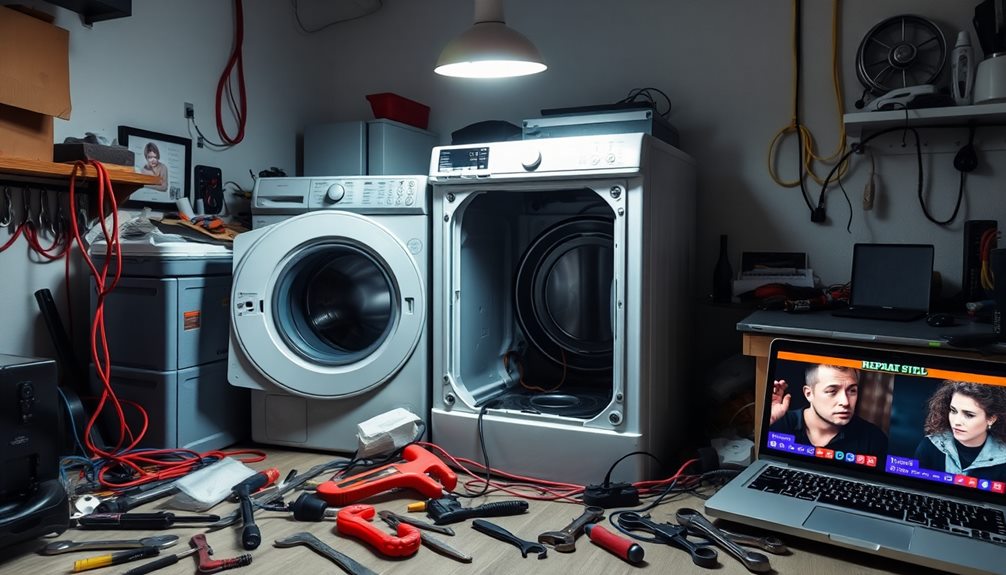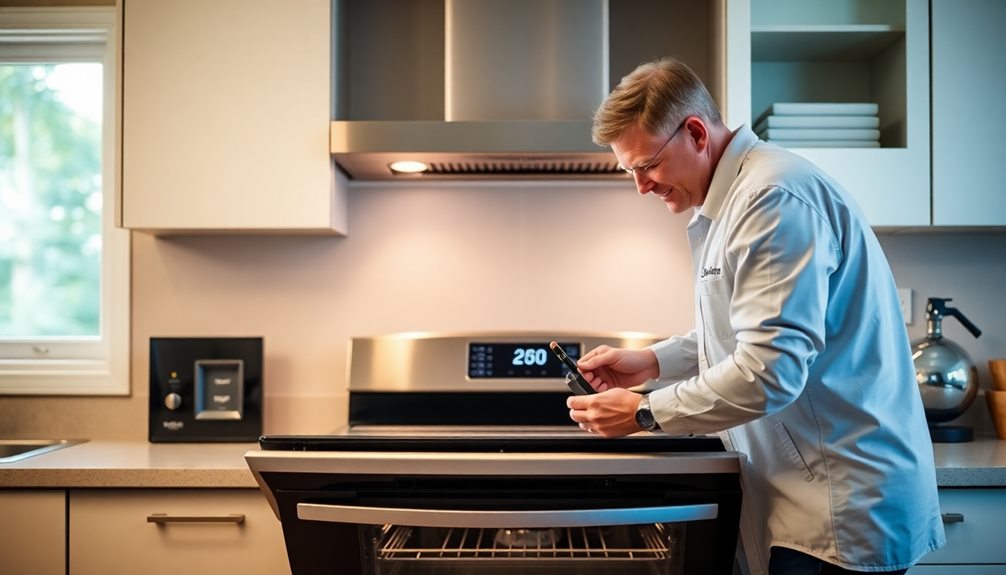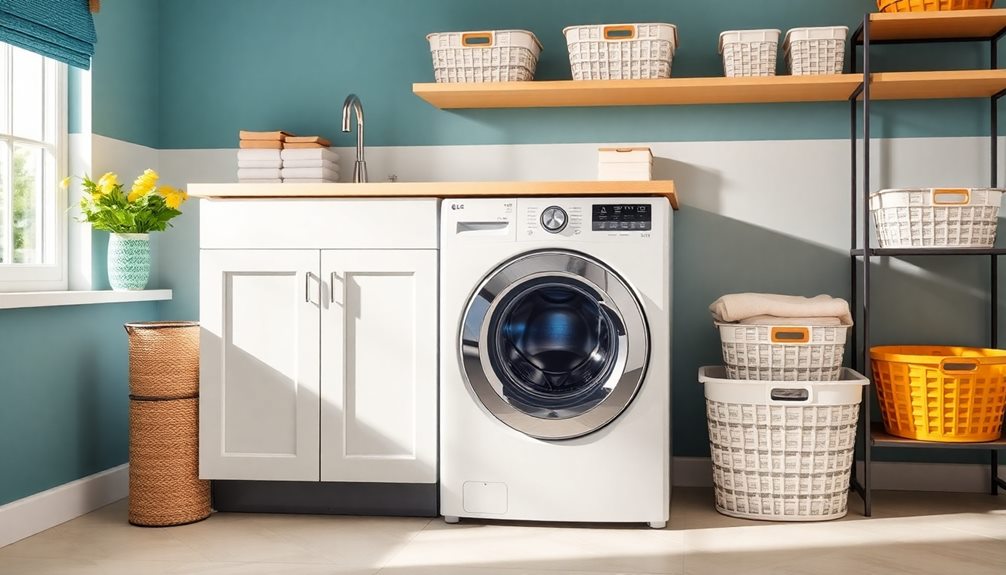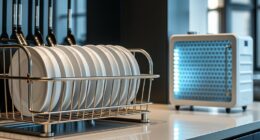Before starting DIY appliance repair, it's vital to be prepared. Identify common issues like poor cooling in refrigerators or drainage problems in washing machines. Gather essential tools, including screwdrivers, wrenches, and a multimeter for electrical diagnostics. Always prioritize safety by disconnecting power sources, wearing gloves, and maintaining a tidy workspace. Know when to call a pro, especially for complex issues or gas appliances. Finally, consider repair costs versus buying new appliances for better value. Understanding these basics will set you up for success, and there's plenty more to explore about the specifics involved in your repairs.
Key Takeaways
- Familiarize yourself with common appliance issues like poor cooling or drainage problems before attempting repairs to save time and costs.
- Gather essential tools such as screwdrivers, wrenches, pliers, and a multimeter to effectively diagnose and repair appliances.
- Always disconnect appliances from power sources and use personal protective equipment to ensure safety during repairs.
- Refer to appliance schematics and user manuals for specific safety guidelines and troubleshooting steps tailored to your model.
- Consider the cost of repairs versus replacement; minor issues may be worth fixing, while repeated problems might warrant a new appliance.
Troubleshooting Common Issues
When your appliances start acting up, it can feel like a household crisis. But don't panic! Troubleshooting common issues with your appliances can save you time and money.
Let's explore some typical problems you might face.
Refrigerators may struggle with poor cooling or water leakage, often due to clogged vents or faulty door seals.
For washing machines, if they fail to drain or spin, inspect the drain hoses and pumps—they're often the culprits.
Ovens not heating properly? Check the heating elements and thermostat; a meter test can help you diagnose broken components.
Dishwashers can also be tricky. If you notice drainage problems, a quick clean of the filters usually does the trick.
Essential Tools for Repairs

Gathering the right tools is essential for successful appliance repairs. To effectively tackle DIY projects, you'll need a reliable toolkit. Start with essential tools like screwdrivers—both flathead and Phillips—wrenches for loosening fasteners, and pliers for gripping and bending various parts.
These repair tools are fundamental when dismantling appliances or making adjustments. Additionally, consider keeping a fire extinguisher nearby in case of any unexpected emergencies, as wood stove safety principles can apply to various repair situations.
For diagnosing electrical issues, a multimeter is critical. It allows you to measure voltage and continuity in electrical components, helping you pinpoint problems efficiently. Don't forget a utility knife; it's handy for cutting through insulation or securing materials during repairs.
Proper tool storage is equally important. Invest in rolling chests or portable toolboxes to keep your tools organized and accessible. This enhances your efficiency while repairing an appliance, ensuring you don't waste time searching for what you need.
Lastly, always have safety equipment, like gloves and goggles, on hand. Protecting yourself from potential hazards is essential while working on home appliances.
Safety Precautions to Follow

Before you start any appliance repair, it's important to prioritize safety. First, always disconnect appliances from their power sources to prevent electrical accidents. This simple step is critical for your protection.
Next, wear personal protective equipment (PPE), such as gloves and safety glasses, to shield yourself from potential injuries during repairs.
Familiarize yourself with the appliance schematics and user manual before diving in. These resources provide essential safety guidelines and outline proper repair procedures, guaranteeing you know what to expect.
Maintain a clean and organized workspace to minimize tripping hazards and facilitate safer repair processes. A tidy area can make a significant difference in preventing accidents.
If you're working on gas appliances, make sure the gas supply is turned off. It's also important to confirm that the area is well-ventilated to avoid any potential hazards during your repairs.
Taking these safety precautions seriously will help you create a safer environment and make your DIY repairs more effective. By following these guidelines, you can tackle your appliance issues with confidence and peace of mind.
When to Seek Professional Help

Sometimes, tackling appliance repairs on your own can be a rewarding experience, but knowing when to call in a professional is vital to avoid further complications. If you're facing complex issues involving intricate electrical systems or advanced technology like smart appliances, it's wise to seek professional help. These situations often demand a skill set that exceeds DIY capabilities.
If you find yourself repeatedly fixing the same problem without success, it might signal a deeper issue that requires a professional assessment. Additionally, lacking the proper tools or specialized equipment can hinder safe and effective repairs, making an appliance repair service a necessary option.
If you're unfamiliar with specific appliance models or repair processes, consulting a technician can prevent costly mistakes and guarantee proper handling.
Most importantly, never ignore potential safety hazards, such as gas leaks or electrical risks. These situations warrant immediate professional intervention to safeguard your home and well-being.
Cost Considerations for Repairs

When weighing the cost considerations for appliance repairs, it's crucial to understand the various elements that contribute to the overall expense. First, you'll need to factor in the service call fee, which averages around $100. Then, consider the costs of parts and labor, as these can vary greatly based on your specific repair needs.
Here's a breakdown of potential costs:
| Repair Type | Average Cost | Considerations |
|---|---|---|
| Minor Repairs | $20 – $100 | Usually just parts; quick fixes |
| Major Replacements | $100 – $500+ | Can extend lifespan or replace the appliance |
| DIY Repair | $0 – $200 | Parts only; requires skill and time |
Before committing to a repair job, compare the estimated repair costs against the price of a new appliance. Sometimes, investing in repairs for older appliances isn't cost-effective if they won't greatly extend their lifespan. Evaluate whether it's worth it to call an appliance repair company or to tackle a DIY repair to save on expenses. Always consider all these factors to make an informed decision.
Frequently Asked Questions
What Should You Do Before Fixing an Electrical Appliance?
Before fixing an electrical appliance, unplug it, check the manual for safety guidelines, inspect for visible issues, and use a multimeter to test components. Familiarizing yourself with safety practices is essential to prevent injuries.
What Is Your Process for Deciding if an Appliance Should Be Replaced or Repaired?
Like choosing between Icarus's flight and stability, you weigh your appliance's age, repair costs, efficiency, and warranty. If repairs threaten to exceed half the replacement cost, it's often wiser to invest in a new one.
Is It Worth Fixing Old Appliances?
It depends on your appliance's age and repair history. If it's old and frequently breaking down, you're likely better off replacing it. Newer models often save you money on energy and repairs in the long run.
How Do You Know That the Appliance Is Already Damaged?
You'll know an appliance's damaged if it makes unusual noises, leaks, or fails to start. Watch for flickering lights, rust, or frayed wires, too. These signs often mean it's time for repair or replacement.
Conclusion
As you commence your DIY appliance repair journey, think of yourself as a skilled sailor steering through the sea of challenges. With the right tools and safety precautions, you can guide your ship through stormy waters. Remember, some waves are too strong to tackle alone, and that's when it's wise to call for a lighthouse's guidance. Balance your budget like a seasoned guide, and soon, you'll find yourself mastering the art of repair with confidence.










